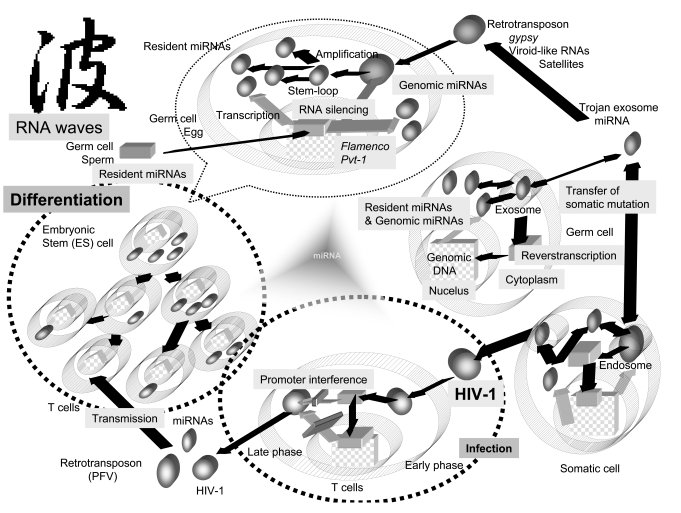Fig. (1).
Diagram of mobile miRNAs under the RNA wave hypothesis. Two categories of miRNAs, resident and genomic miRNAs are represented. RNA and DNA information is shown in circles and squares, respectively. Genomic DNA of human cells is represented by large checkered squares. Black arrows represent the flow of RNA and gray arrows that of RNA intermediates from transcription of DNA information. When retrotransposons, viroid-like RNAs and satellites horizontally infect germ cells, the RNA intermediates are a source of small RNA through RNA silencing. The resident miRNAs derived from small RNA are reverse -transcribed and become genomic miRNAs. The genomic miRNAs are vertically inherited and the resident miRNA information is pooled into the host genome. Further, miRNAs are horizontally transmitted by Trojan exosomes between germ and somatic cells, or among these cells. Some miRNAs, such as HIV-1 miRNAs, jump into MGE tags, and miRNAs in MGE can infected blood cells. The information of miRNA in MGE on the genome is silenced by promoter interference. On the other hand, since the represented genetic information would be involved in the resident miRNA, divided ES cells would have asymmetric and inheritable characters if the resident miRNA information is asymmetric. Therefore, the combination of infection of viruses and MGEs with miRNAs may contribute to the elucidation of evolution and differentiation of cells. For example, these aspects may partially explain the imprinting phenomenon and the susceptibility of T cells and macrophages to HIV-1. The Japanese Kanji character ‘nami’ in the top left of the figure is the symbol for waves.

